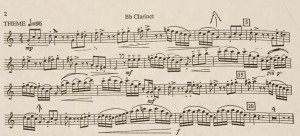Quick Fix Friday – Lunglock
Breathing.
I’ve always thought it was funny that we spend our entire life without thinking about it, then we pick up an instrument (with a few exceptions, of course) and forget everything we know about breathing. Wind instrumentalists will undoubtedly spend many hours studying charts and diagrams of the lung’s relation to the oral cavity; attend several lessons or masterclasses on the discussion of “proper breathing”; or even take up cardio activities (hey, it can’t hurt!). There are even courses designed to facilitate better breathing techniques, such as The Breathing Gym. How can something so natural cause so much angst among musicians (unless you had the foresight to choose violin, piano, or percussion to avoid respiratory distress)?
Alas, this is not an in-depth examination of breathing. (If you’re looking for that, check out Arnold Jacobs’ book “Song and Wind.”) This is a common problem which has plagued us all at some point, and it’s a very simple solution – you’re breathing too much. At times, we’ve all wished for more air, but have you ever felt the need to expel your air? This happens when you take a larger amount of shallow breaths, rather than focusing on taking fewer and higher-quality breaths. I’ve nicknamed this phenomenon “lunglock”
The obvious solution is to not breath as often, but you should also be aware of the main trigger in music – rests. It’s subconsciously emblazoned in our musical beings to “relax” during a rest (hence the term) or to take a preventative breath to avoid breathing later in the middle of a phrase (breath hoarding?), but this can do more harm than good.
Take a look at the well-known tune below (the Theme from Rossini’s “Introduction, Theme, and Variations” for clarinet). If you took a breath during every rest, you would breathe 13 times (14, if you count the initial breath) in a 25-measure section, which is completely unnecessary and traps stale air in your lungs. Also keep in mind that rests are often part of the music, and by breathing in a rest you are interrupting the flow of the phrase.
The solution? Carefully plan your breaths and practice implementing your breathing spots. Also, make sure that each breath counts – don’t take a perfunctory breath just because there is a rest. Finally, make sure you completely fill your lungs when you begin so there is no need to take extraneous breaths.
Now take a deep breath (just one really good one, not several shallow ones!) and go practice!

One Comment
Dana
When you taught me this it was an eye opening for me when you taught me this. Of course, it takes practice and had to remind me several times. An over 30 year habit to break. I was able to do this in 2 good breaths. Is that good? You are the best teacher I have ever had. Thank for,coming into my life.